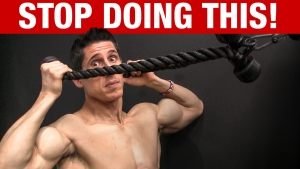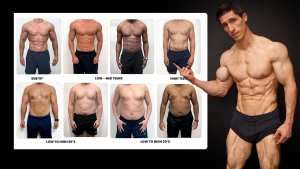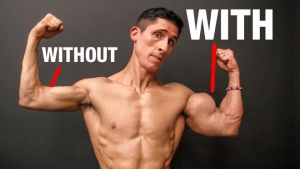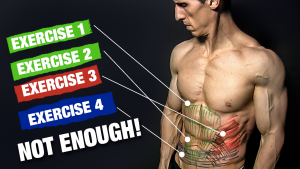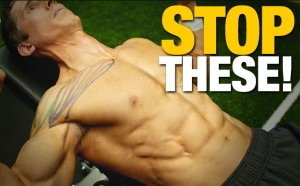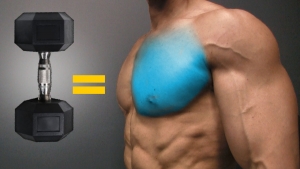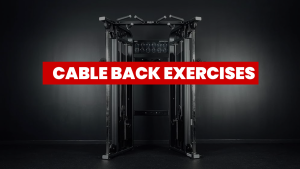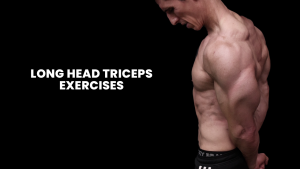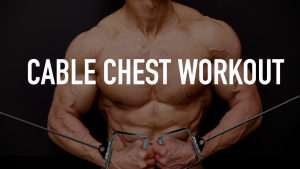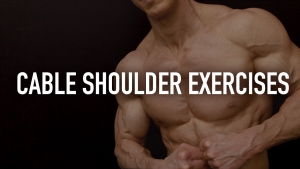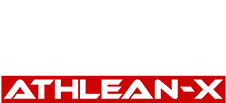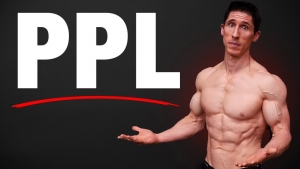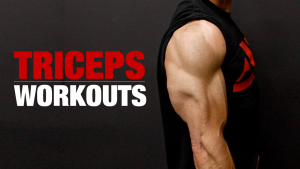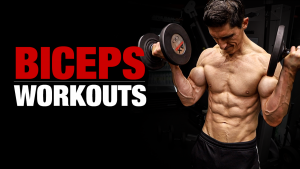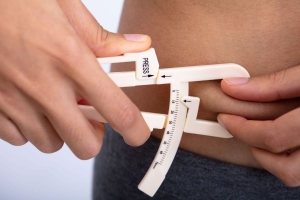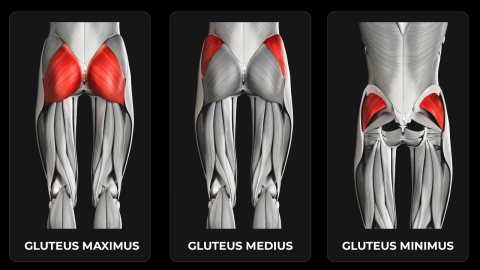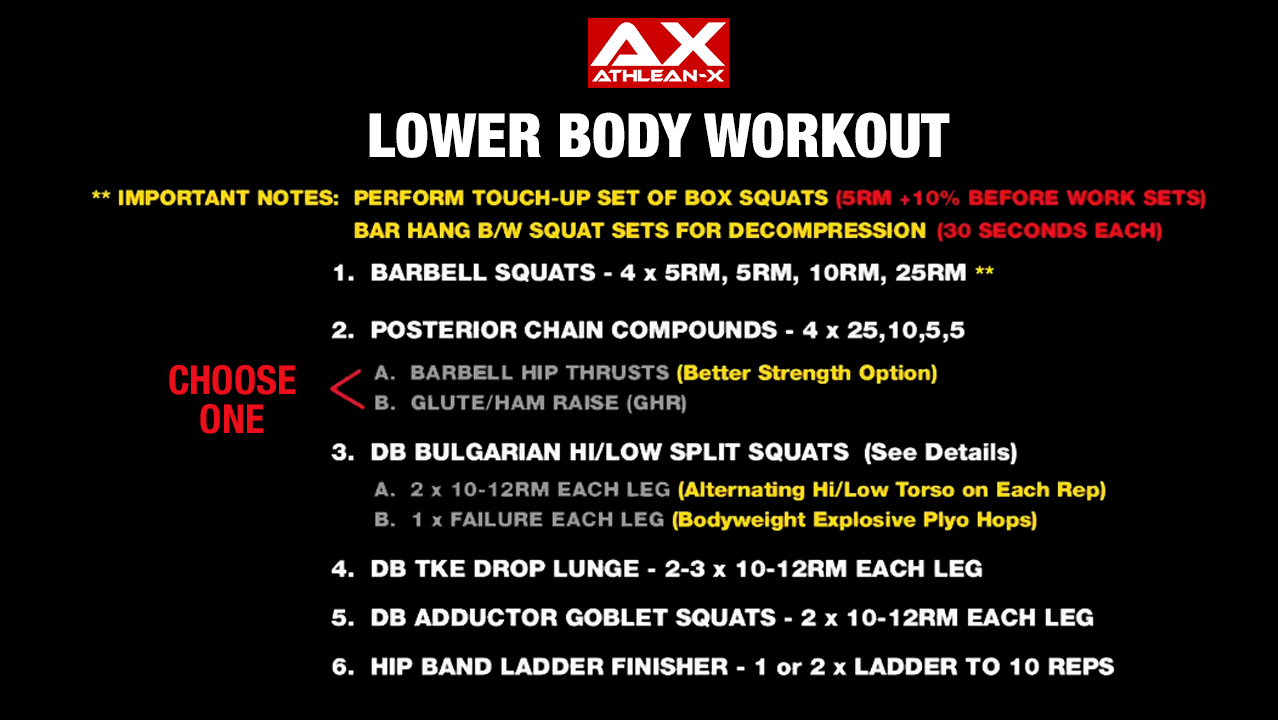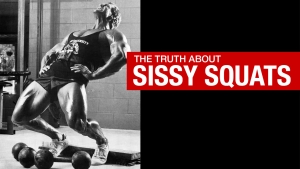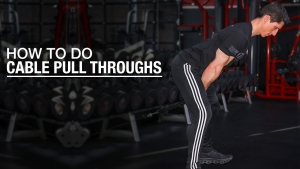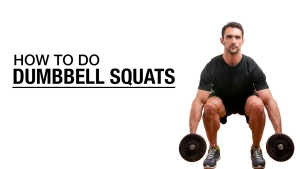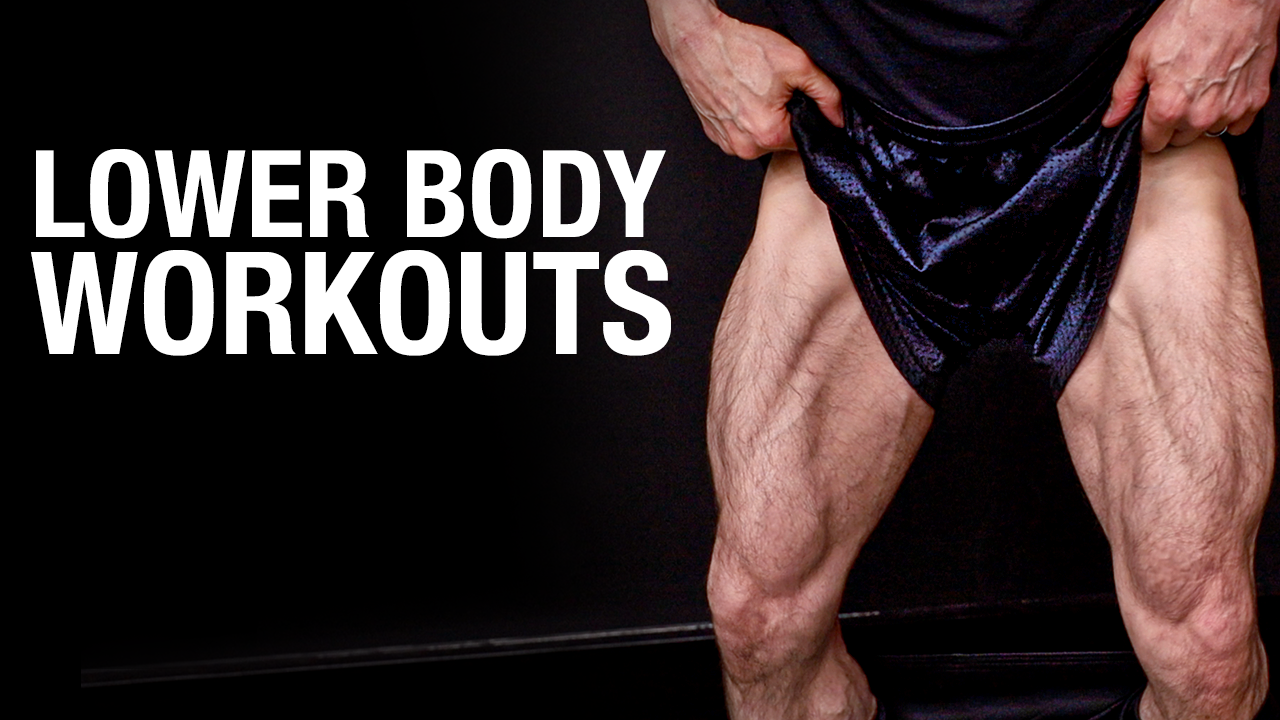
As they say, there are many ways to skin a cat… so how do we construct the best lower body workout routine that will ensure you will build not only muscle size but muscular strength and explosiveness as well?
First we want to realize that there are a couple of serious issues with the typical leg training session that we have to fix!
- Most leg workouts only work in the sagittal plane, so we want to fix that by making sure we’re also including lower body strength exercises that work in the transverse and frontal planes.
- Typical leg strength training workouts for men hit the major muscles but neglect some of the smaller muscles. We need to fix that by working ALL the muscle groups including smaller ones.
The best lower body workout should overlook no component of upper leg training to ensure we’re hitting the hips, the glutes, the hamstring muscle, and the quads and working in all three planes of motion.
Don’t let anyone mislead you!
While the Squat is a GREAT and effective movement, you can’t develop all the muscles optimally with JUST that exercise.
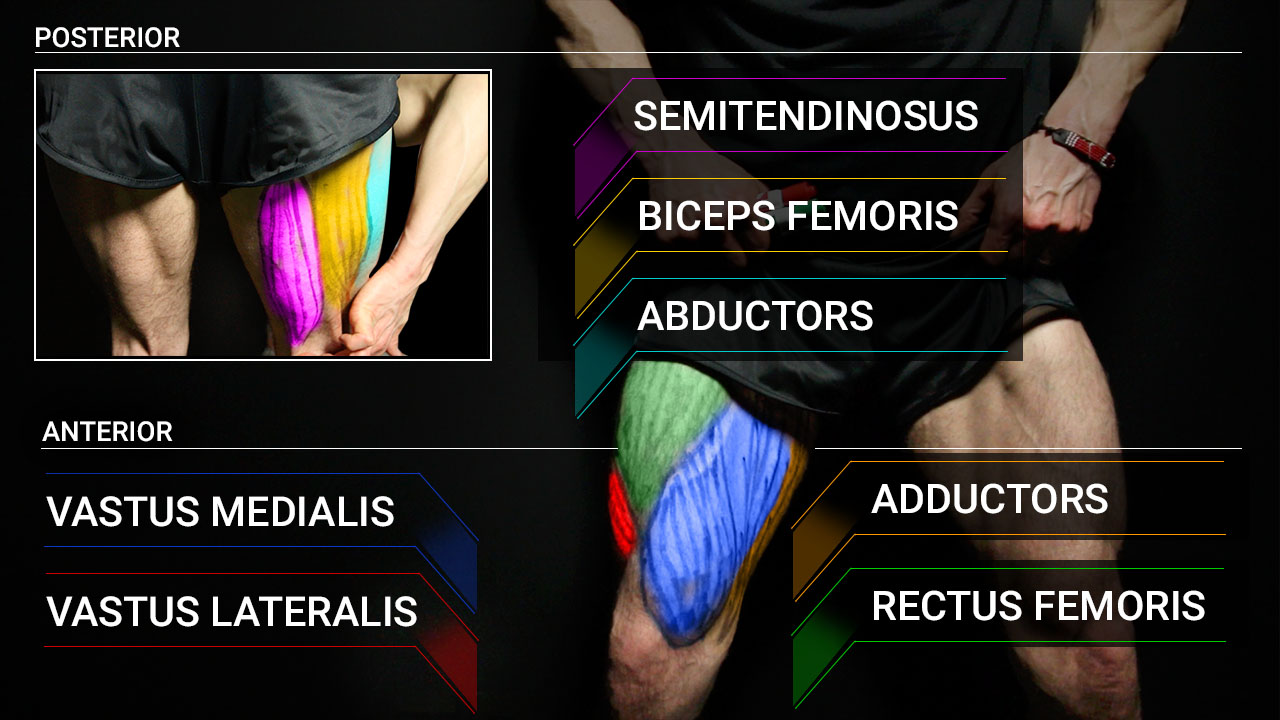
THE LOWER BODY MUSCLE GROUPS
The best lower body workout routine needs to hit several important muscle groups in the legs: the quads, the hamstrings, the adductors, the abductors and the glutes.
I’ll demonstrate the leg anatomy with the Muscle Markers to help show how each of these muscle groups functions.
By the way, there will be NO MUSCLE MARKERS FOR THE GLUTES.
Jesse did volunteer, but it ain’t going to happen, guys.
(You’ll have to use your imagination.)
THE QUADRICEPS MUSCLES
True to its name, the Quadriceps has four components:
VASTUS MEDIALIS

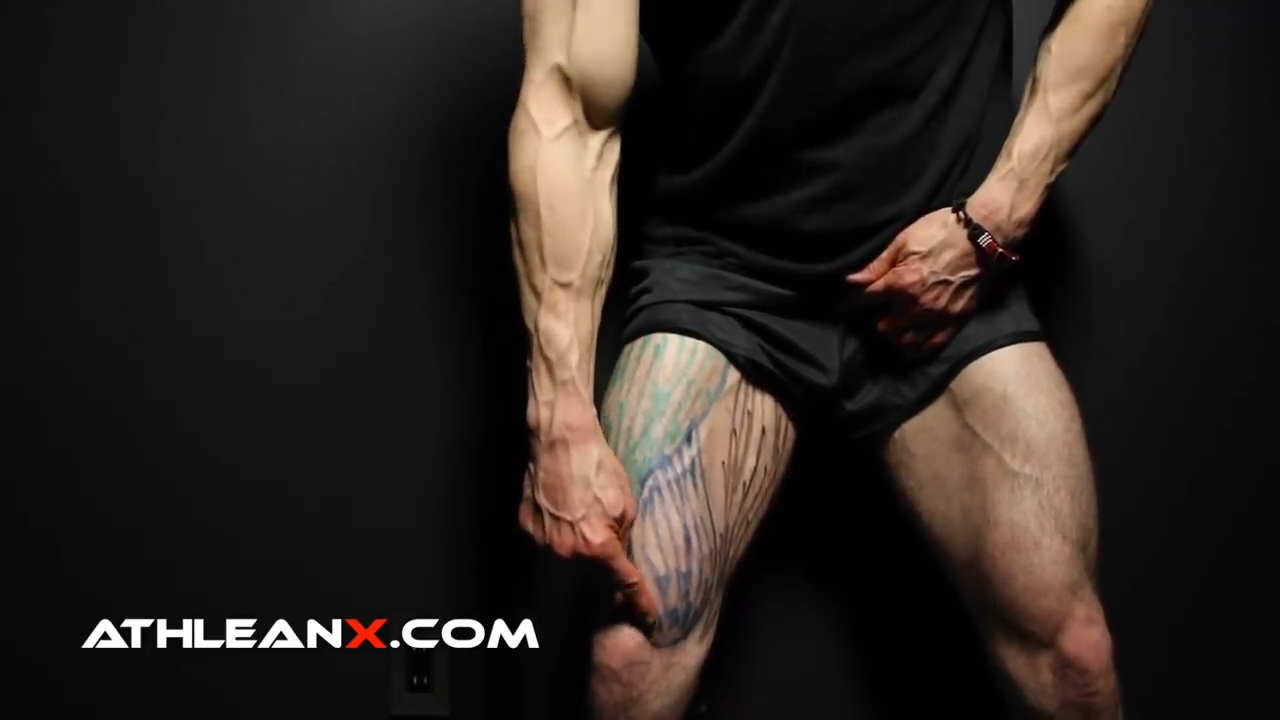
VASTUS INTERMEDIUS

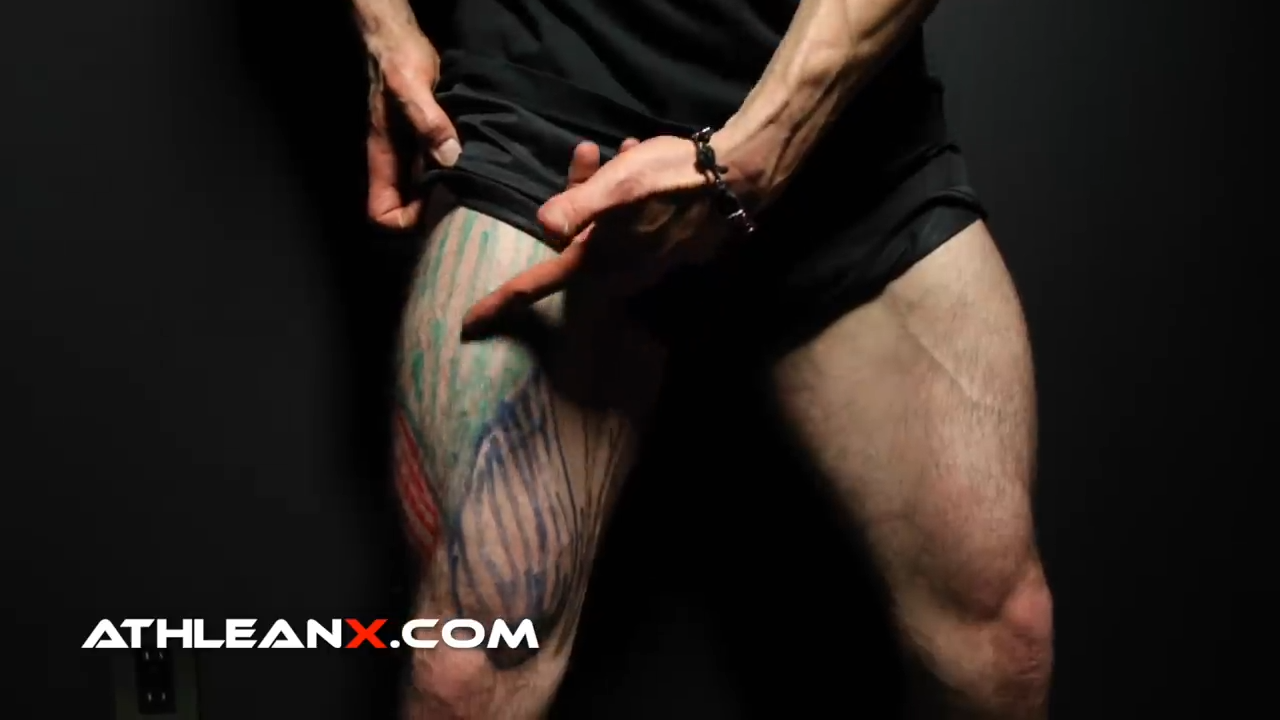
VASTUS LATERALIS

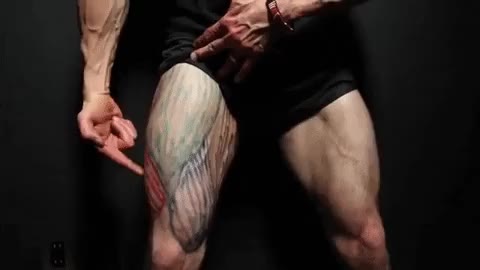
RECTUS FEMORIS

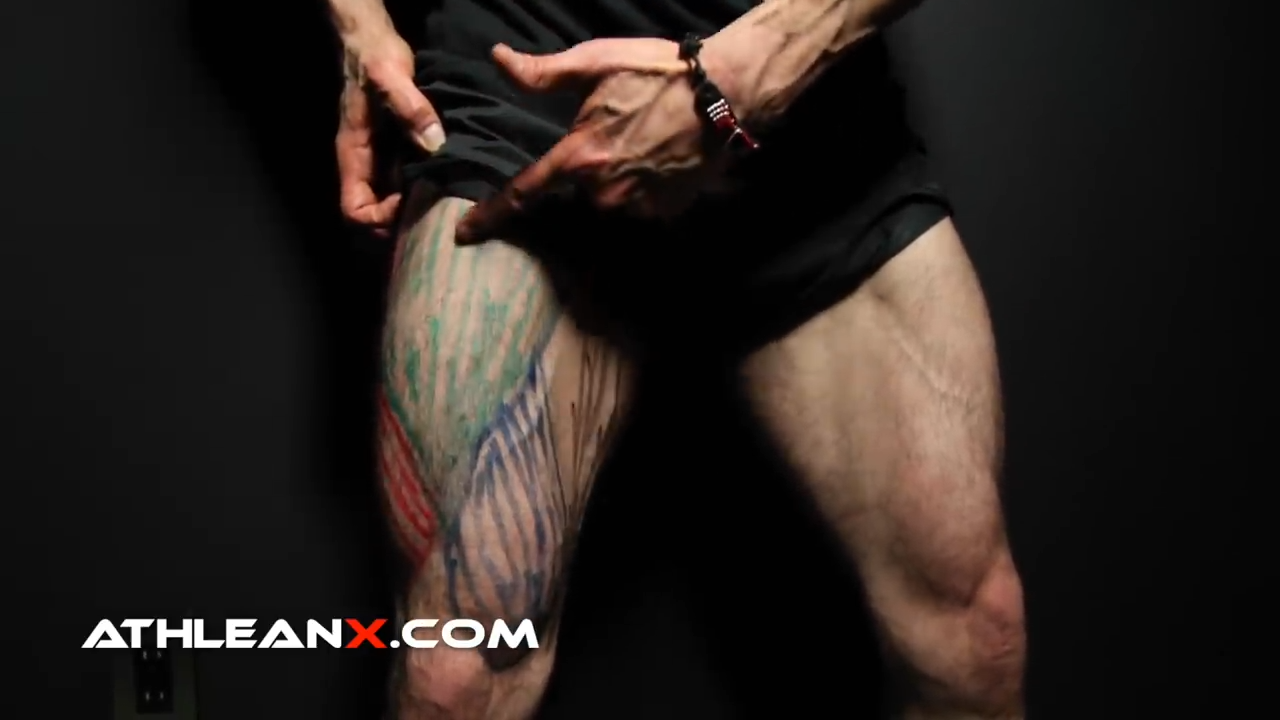
THE HAMSTRINGS
On the back side of the legs, the Hamstrings have two main muscle groups we want to make sure we’re focusing on:
BICEPS FEMORIS

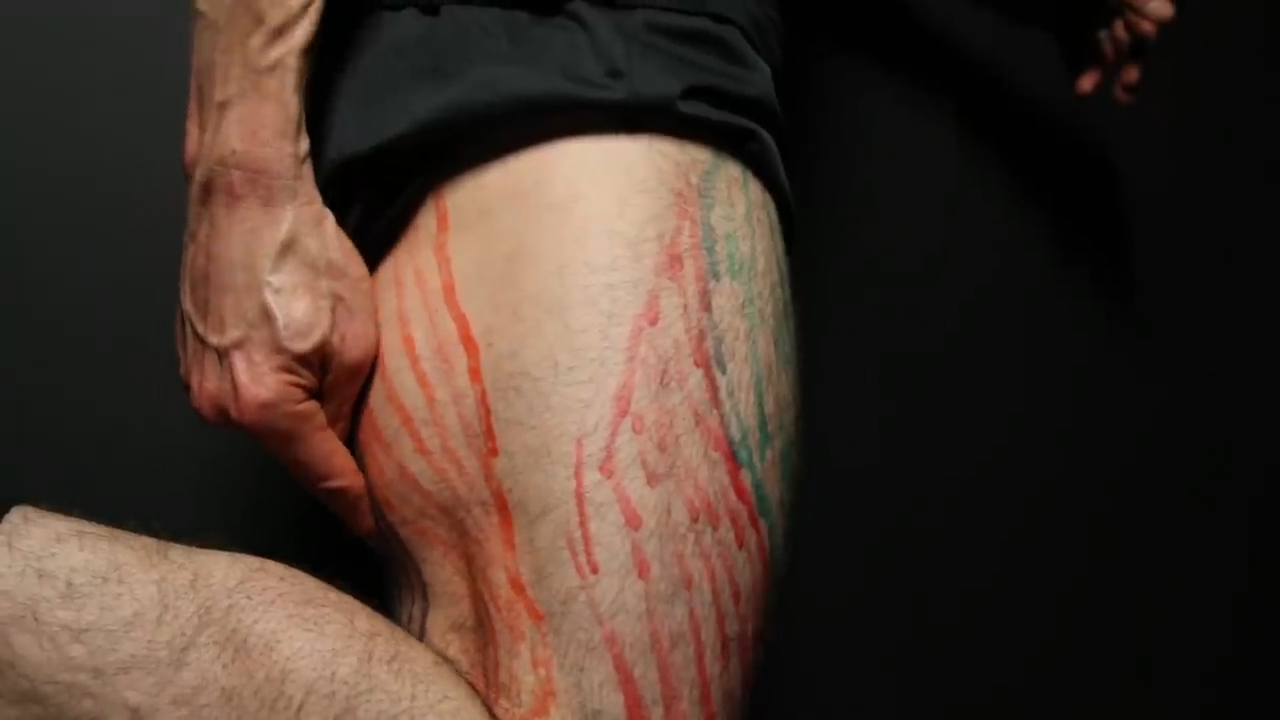
SEMITENDINOSUS

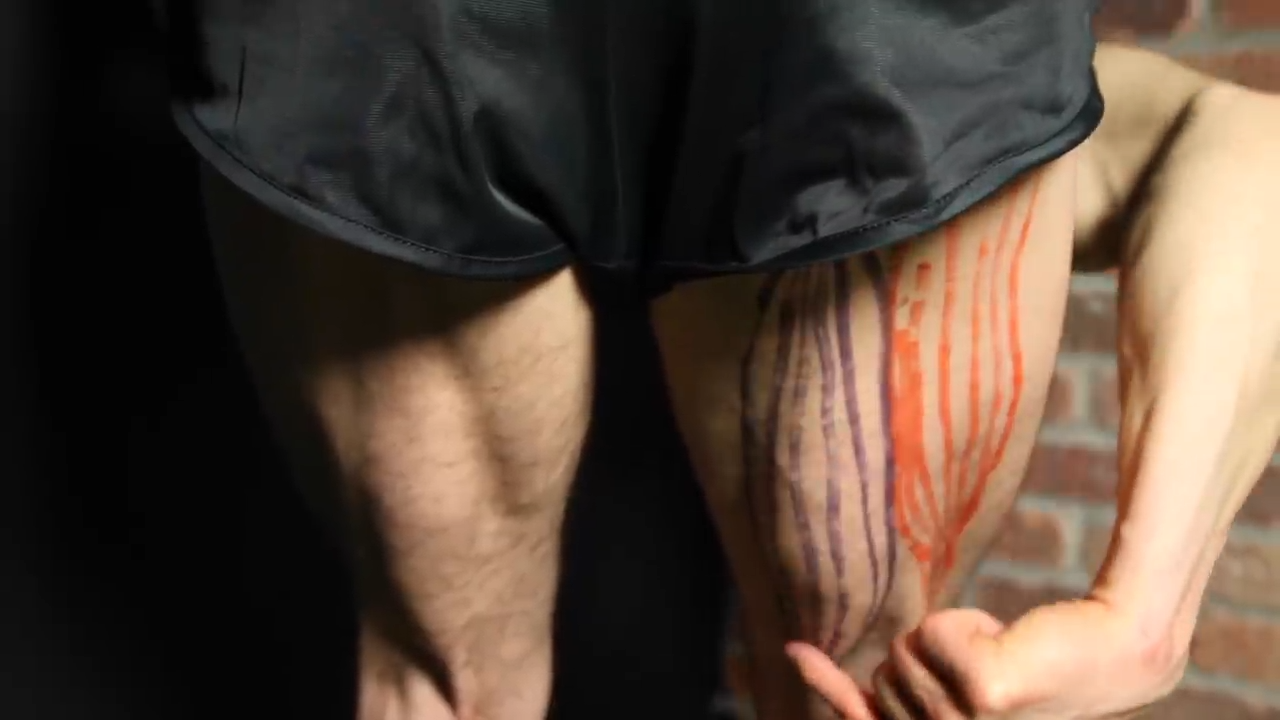
THE ADDUCTORS
On the inside of the legs, the Adductors are a muscle group that many people neglect in their training but they are important:
ADDUCTORS

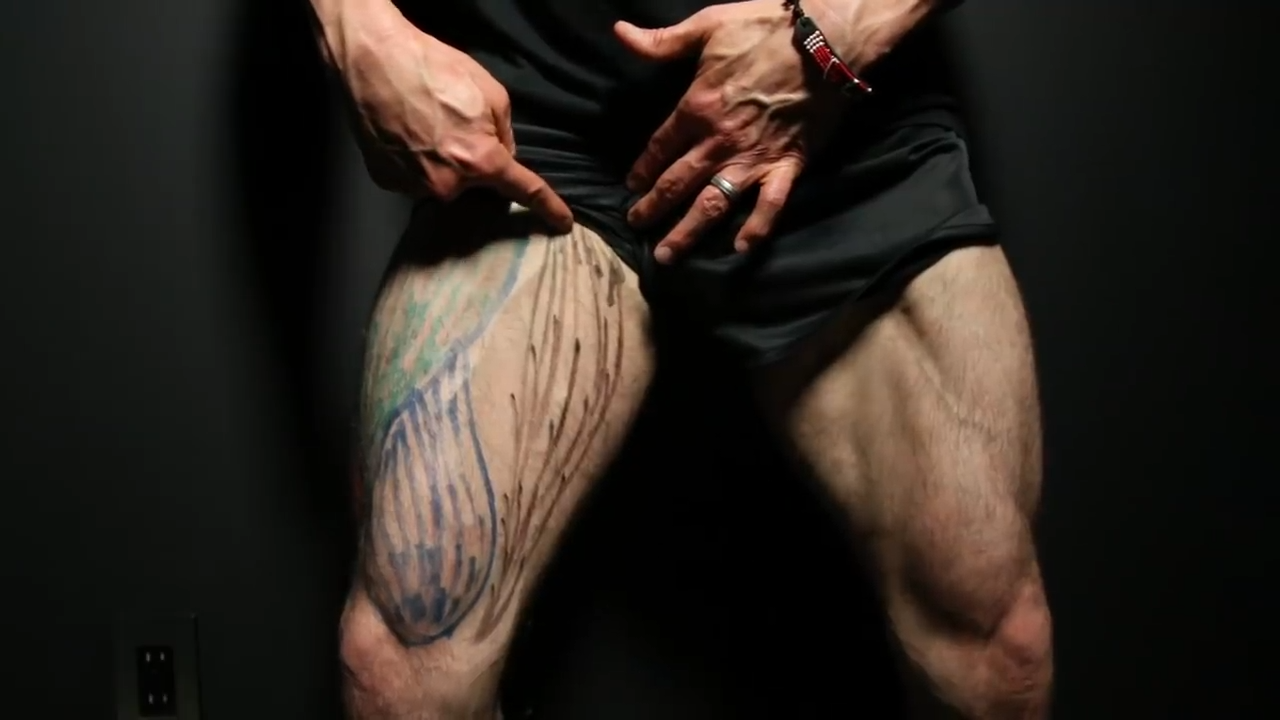
THE ABDUCTORS
The Abductors are a muscle group on the outside of your legs that require separate targeted training:
ABDUCTORS
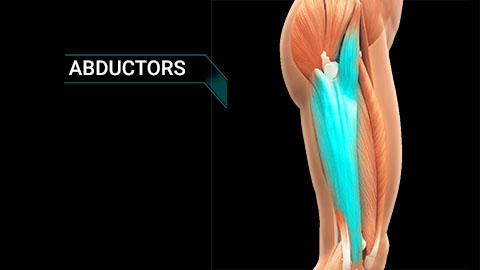
The Abductors are a chronically weak muscle that needs to be targeted separately.
THE GLUTES
On the back of our body are the gluteal muscles, and there are actually three separate muscles there. The glutes sometimes like to be lazy and don’t activate, so being able to visualize the muscles in this area can help you build that crucial mind-to-muscle connection so you can get them to kick in.
LOWER BODY WORKOUT: STEP BY STEP
The best lower body workout routine must consist of compound exercises for the quads, glutes and hamstrings while not overlooking the smaller muscles of the hips and our ability to train in all three planes.
THE WARMUP
This lower body workout routine will kick off with a good compound exercise. The best, when it comes to training legs, is the Squat.
We’re going to work our way up to the Squat movement in a warmup fashion using some submaximal sets.
While warming up, the key is not to exhaust yourself more than necessary. Often people perform too many warmup reps, cutting into energy reserves for their working sets.
Try to use half of your working weight and then about 20% less than what your working weight is going to be, and just do a few reps with each weight. Just enough to ‘grease the groove’ and warm up the joints to prepare yourself for the working sets.
SUBMAXIMAL SQUAT SETS


HOW TO DO SUBMAXIMAL SQUAT SETS:
- To warm up for the Squat perform submaximal sets of a few reps each of half your working weight and 20% less than your working weight.
- Starting position is with feet shoulderwidth apart, grabbing the bar from the squat rack, lower into squat position until legs are parallel to the floor or just beyond parallel, being sure to maintain balance and keep your core tight throughout the entire movement.
- Push through your heels to return to the start position.
I also like to include some touch up sets using a Box Squat. With a touchup set, we’re trying to overreach with an additional 10% more weight than what we’re going to use in our first working set, to our five-rep max.
That 10% overreach allows us to feel more ready and able to attack our working sets with a lighter weight. Neurologically it’s a powerful tool to help “lighten” the load that is to come.
Doing the touch up sets with box squats has the benefit of allowing us to squat down and feel the safety of the box, giving us the confidence that we have a bottom point. It will give us biofeedback to know, ‘that’s the point I’m heading for’. Give it a one or two rep touch, come back up, then start your working sets.
BOX SQUAT TOUCH UP SETS

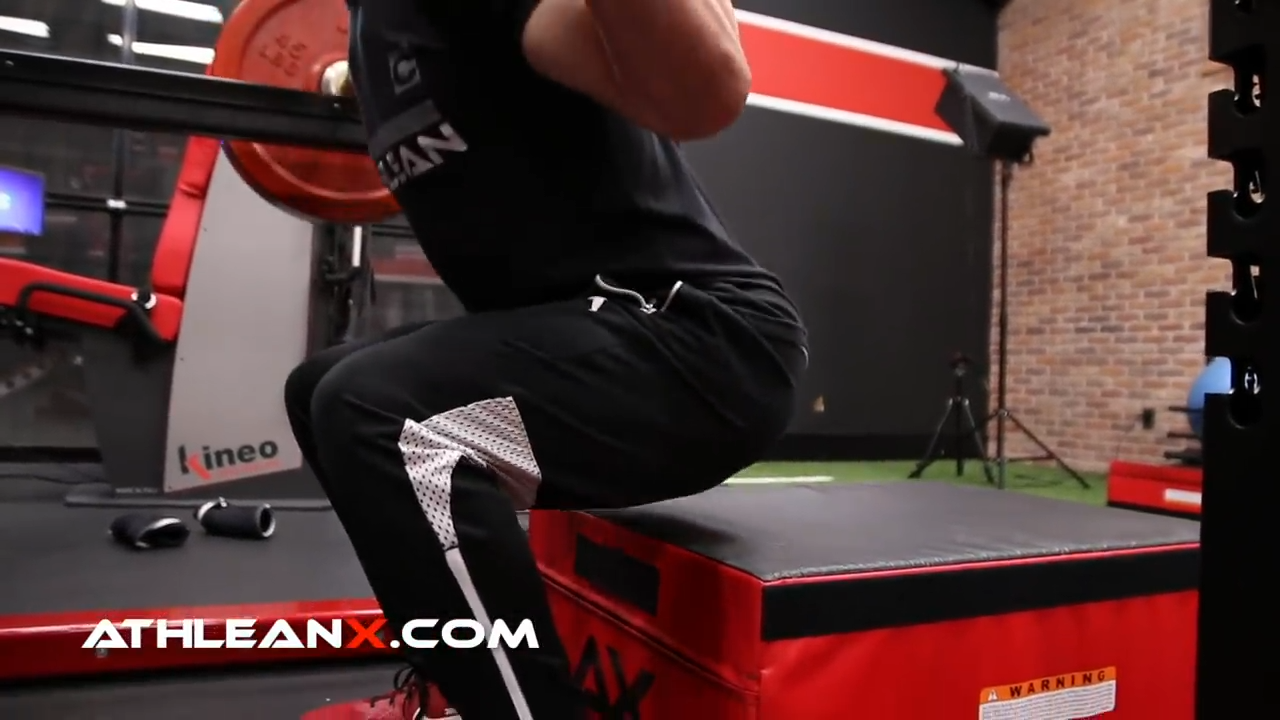
HOW TO DO BOX SQUAT TOUCH UP SETS:
- Doing a few Box Squat Touch Up Sets allows us to feel a bottom point in the movement. Use 10% more weight than what you’re going to use in your first working set.
- Be sure to maintain core stability throughout the movement.
1.) ANTERIOR CHAIN COMPOUND LIFTS
Now we’re starting with our heavier sets of the barbell squat, and they should feel a little lighter after your touch up sets.
The squat is one of the foundational lower-body exercises for building strength in the lower body muscle.
Our first two sets are a 5RM, then work ourselves up to a 10RM, and then a grueling 25RM. Training your legs up to higher reps is important if, for nothing else, to train your mental fortitude.
With squats as with any of the advanced lower-body exercises, make sure you have researched and are using proper form. Bad form in compound movements like the squat increases risk of injury.
BARBELL SQUATS

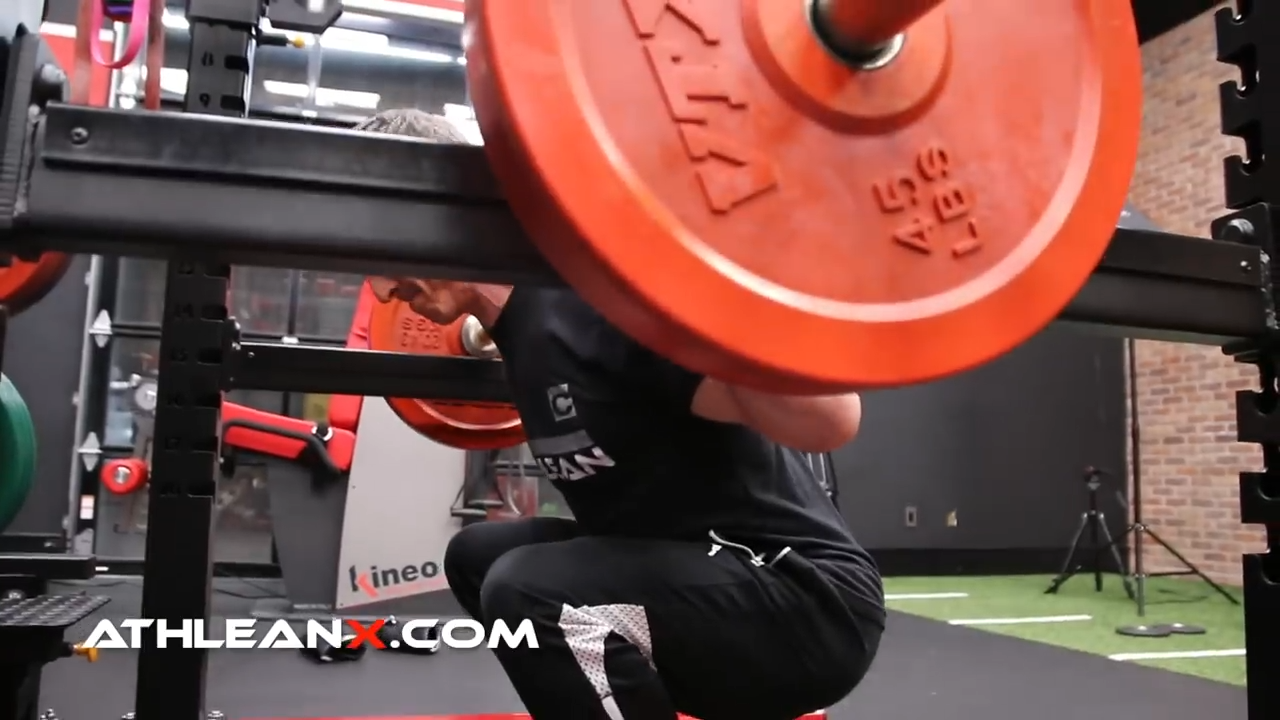
HOW TO DO BARBELL SQUATS:
- Your first 2 sets are 5RM, followed by a 10RM set and then a 25RM set. Starting position is standing with your feet flat shoulder width apart, grabbing the bar from the rack and begin slowly lowering your body through the entire range of motion in a smooth controlled movement until your thigh muscles are parallel or just beyond parallel to the floor in a deep squat (as your range of motion allows).
- Then return to the upright position. Ensure you are using proper squat form and engaging the core muscles, because bad form increases the risk of injury.
- Perform a 30 Second Bar Hang (see below) between sets.
- Take rest periods of about three minutes between work sets.
We’ve got some compression going on because of the moderate weight loading of the bar squat. When we pair the Squat with a 30 Second Bar Hang, the hanging allows us to get a decompressive benefit.
30 SECOND BAR HANG

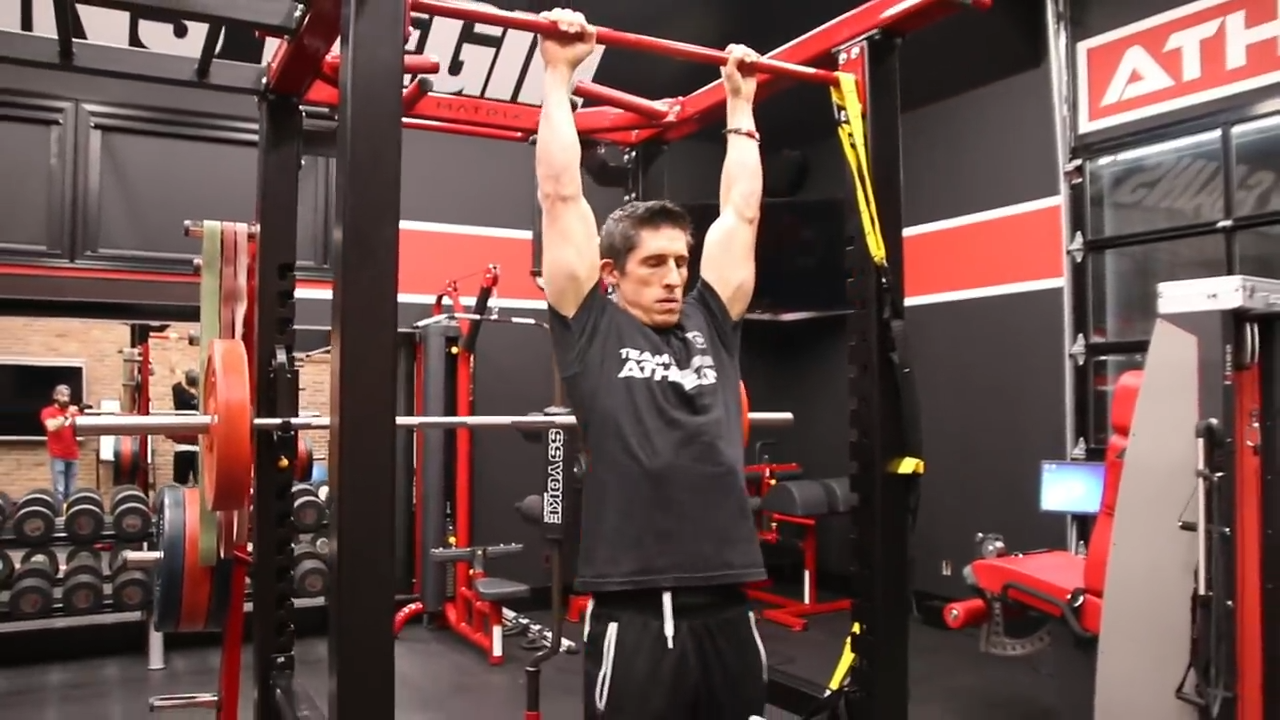
HOW TO DO THE 30 SECOND BAR HANG:
- Grab the bar with an overhand grip and just hang there loose.
- Performing a 30 Second Bar Hang following each set of Squats gives us a decompressive effect which helps avoid back injuries.
2A.) and 2B.) POSTERIOR CHAIN COMPOUND LIFTS
Next we’re going to hit the posterior chain with a compound exercise that hits the hamstrings and glutes in one powerful movement.
I’ll give you two compound leg exercises to choose from, but you’ll just do one of them. Either of these lower-body exercises is great for strengthening your legs and building bigger legs.
You might be expecting the traditional deadlift here, but instead of the traditional deadlift I’d like to provide you with an alternative exercise so that you have a wide range of workout ideas for training the target muscles in the posterior chain.
OPTION 1: The Barbell Hip Thrust allows us to load up much heavier than Option 2, so you’ll want to choose this option if your main goal is training for lower body strength. If you choose the hip thrusts, we’re going to work backward in a 25-10-5-5 rep sequencing.
This helps you recruit your glutes to be the main driver of the movement, and then allow the hamstrings to assist. Many of us do not have good control over our glutes, so starting out with the lighter weight helps us to establish that mind muscle connection to the glutes.
Try to establish that purposeful movement, initiating with the glutes, and then squeezing with the hamstrings. Doing this with a light weight allows us to get into the movement pattern, and then as we get more comfortable we begin to use heavy weight.
OPTION 1: BARBELL HIP THRUST

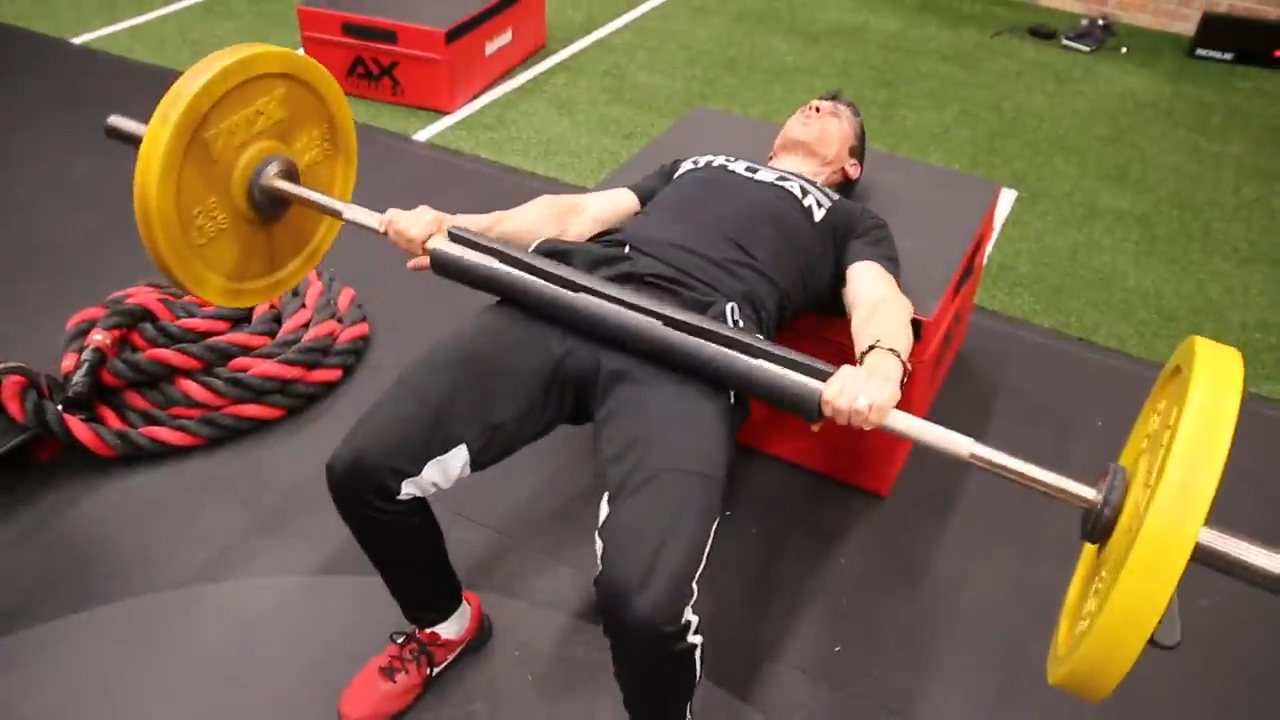
HOW TO DO THE BARBELL HIP THRUST:
- Work backward in a 25-10-5-5 rep sequencing. Starting position is lying with your upper body and feet flat on the floor, knees bent at a 90degree angle, and head resting on a box, with the heavy barbell resting on your pelvis near your hip flexors.
- Push your hips up, initiating the movement with the glutes and then squeeze through the hamstrings.
- This is essentially a weighted glute bridges movement that goes a long way to help you build bigger muscles in the entire posterior chain.
- Take rest periods of 2-3 minutes between sets. Ensure you are using proper technique with this lower body exercise because poor form increases risk of injury. Keep the core braced during the movement.
OPTION 2: The Glute Ham Raise is ideal if you are looking to get more active engagement of the hamstrings through their concentric range of motion. The Glute-Ham Raise contributes active engagement in areas that the Hip Thrust only challenges isometrically.
Not everyone has access to the glute-ham raise machine, which takes this alternative exercise off the table right off the bat. But if you do have it, I’m going to explain why it provides some additional benefits.
OPTION 2: GLUTE HAM RAISE

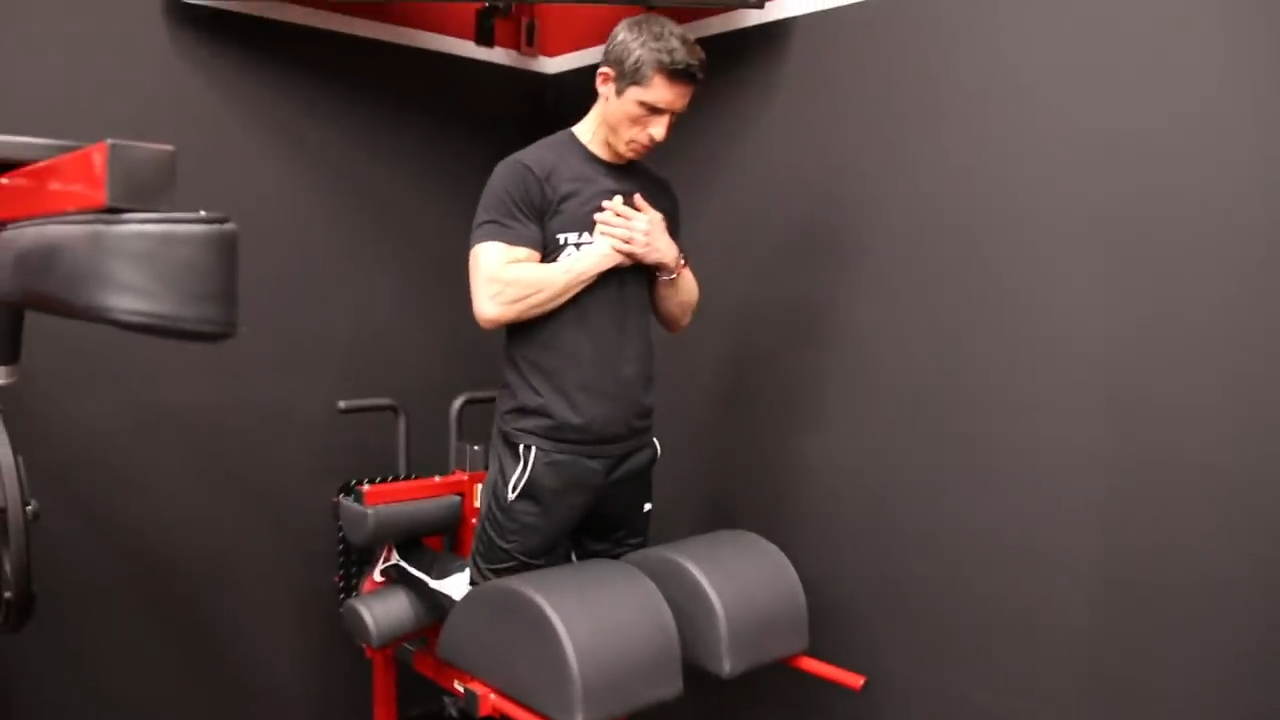
HOW TO DO THE GLUTE HAM RAISE:
- If you choose the Glute-Ham Raise for this training session you would still use the same 25-10-5-5 rep scheme, but you’d have to load yourself appropriately. To do that you may have to use an assisted version, using your hands to creep yourself up during the first portion of this exercise.
- You may also want to include some additional weight held across your chest to allow you to fail in those heavier ranges.
- Keep the core strong during this exercise. Take rest periods of 2-3 minutes during sets.

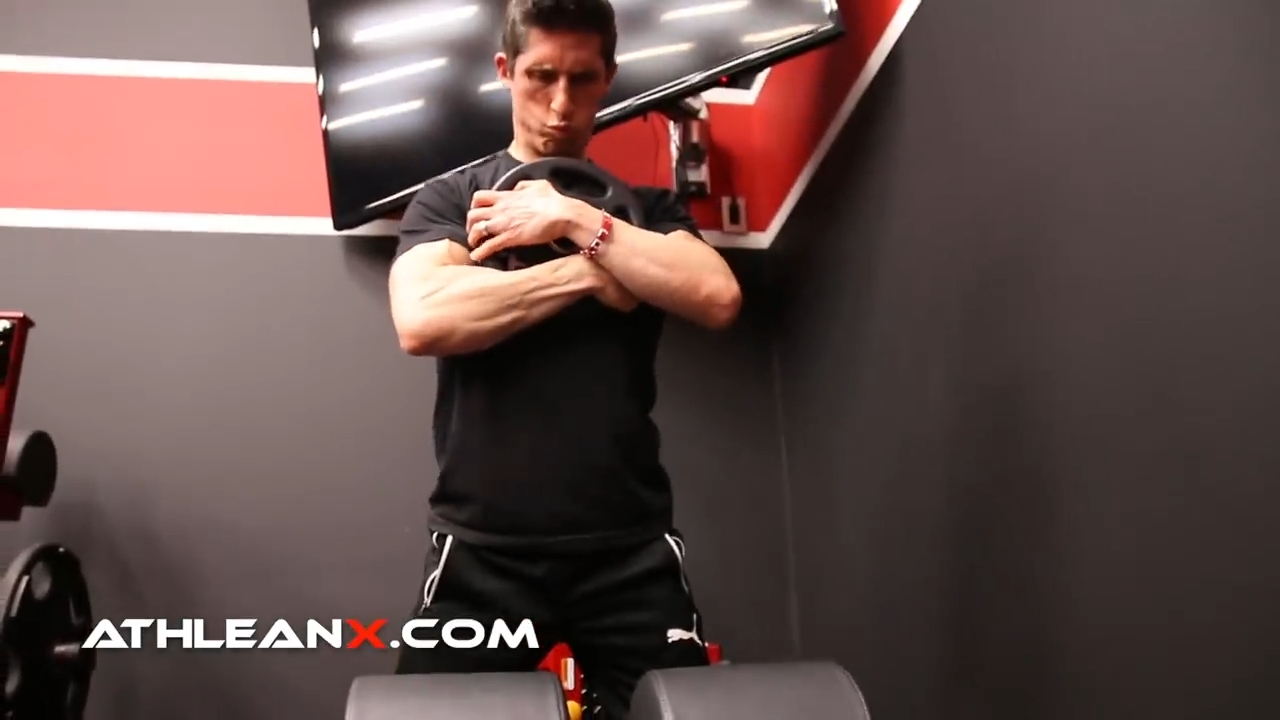
In the Glute-Ham Raise you’re going to feel it much more directly in your hamstrings. However, you will also feel this in your glutes if you squeeze your cheeks together as hard as possible on the initiation of the movement back to the top.

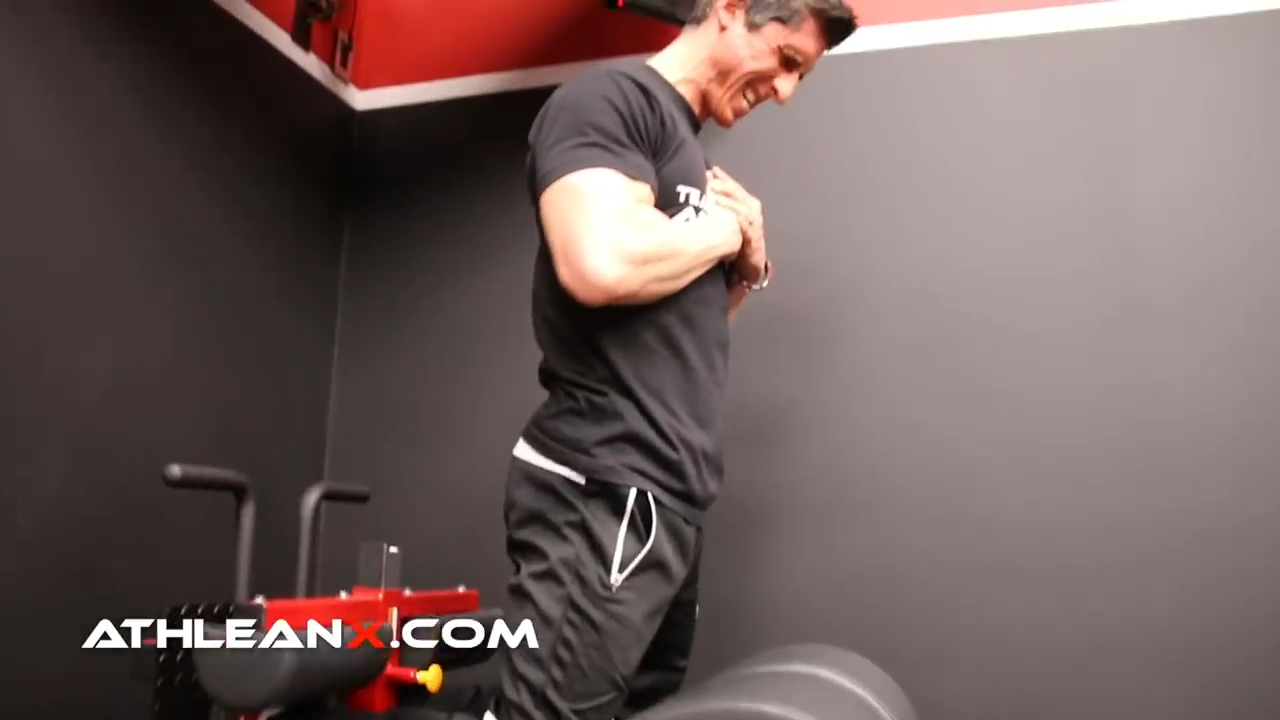
While I do prefer a Barbell Hip Thrust if you’re doing a workout to build leg strength, don’t overlook the value of the Glute-Ham Raise, especially for athletes looking to get stronger glutes and hamstrings.
3A.) SINGLE LEG TRAINING
One of the things I preach all the time as a trainer to athletes is the value of single leg training.
Some unilateral dumbbell leg exercises include the walking lunge or regular lunges and split squats.
Not only do you get dynamic stability benefits in the hips with this type of leg training, but it challenges the frontal plane of the body in ways that traditional bilateral training such as squats cannot do, allowing for additional lean muscle gains. Single-leg strength training can help you work through muscle imbalances since you are working just one side at a time.
Our unilateral exercise is a split squat variation called the Bulgarian Split Squat in High-Low Fashion that you’ll perform with a pair of dumbbells. For these single-leg squats, you’re going to alternate the position of your torso on each rep to ensure you hit both the quads and glutes more effectively on each rep.
DUMBBELL BULGARIAN SPLIT SQUAT IN HIGH-LOW FASHION

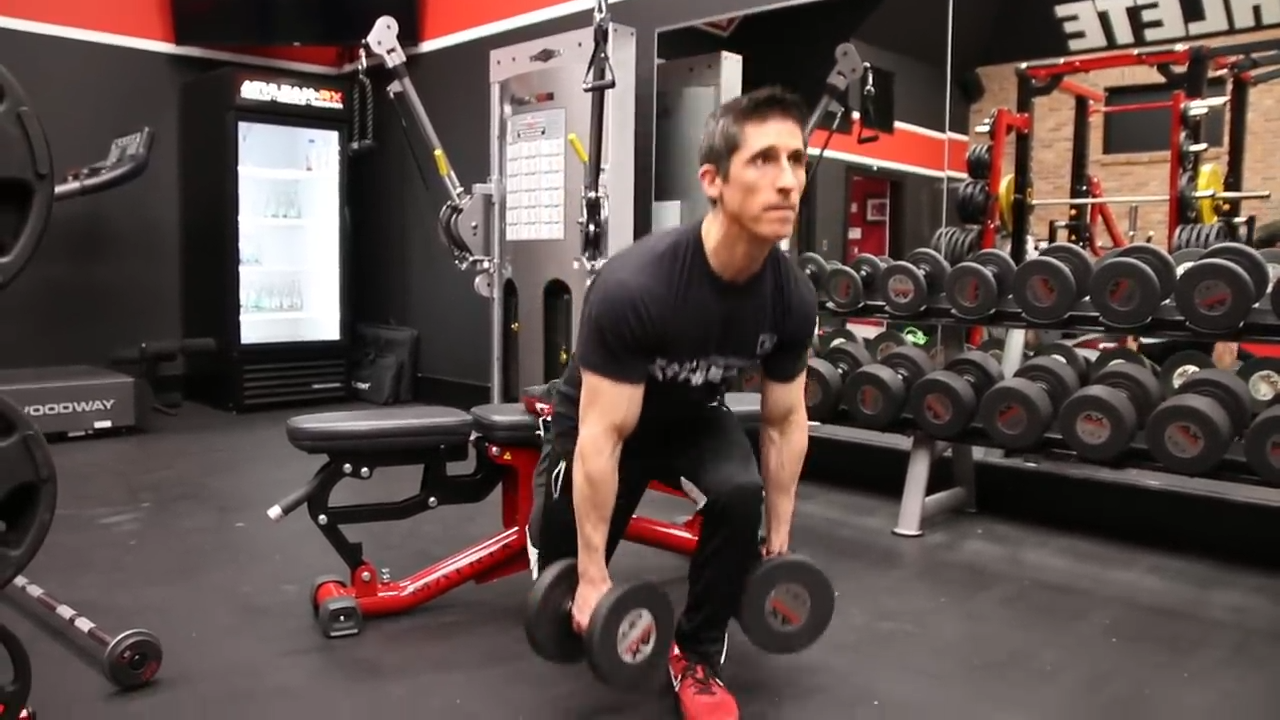
HOW TO DO THE DUMBBELL BULGARIAN SPLIT SQUAT IN HIGH-LOW FASHION:
- 1. Starting position is standing with your left foot on the floor, bending your knee of the left leg and your right leg resting on a workout bench or other elevated surface behind you with a pair of dumbbells in each hand.
- Lower down until the dumbbells touch the floor and then come back up.
- Alternate Bulgarian Split Squat repetitions between upright and sprinter lunge position to failure for two sets. Keep the core strong during this exercise.
We can load this single-leg strength exercise more through our quads, or we can load it more through our glutes and posterior chain, depending upon the angle of our torso on each repetition.
If you drop straight down from the starting position, initiating the lift off from the bottom of this awesome exercise through the quads, you’ll get the most muscle recruitment and overload there.

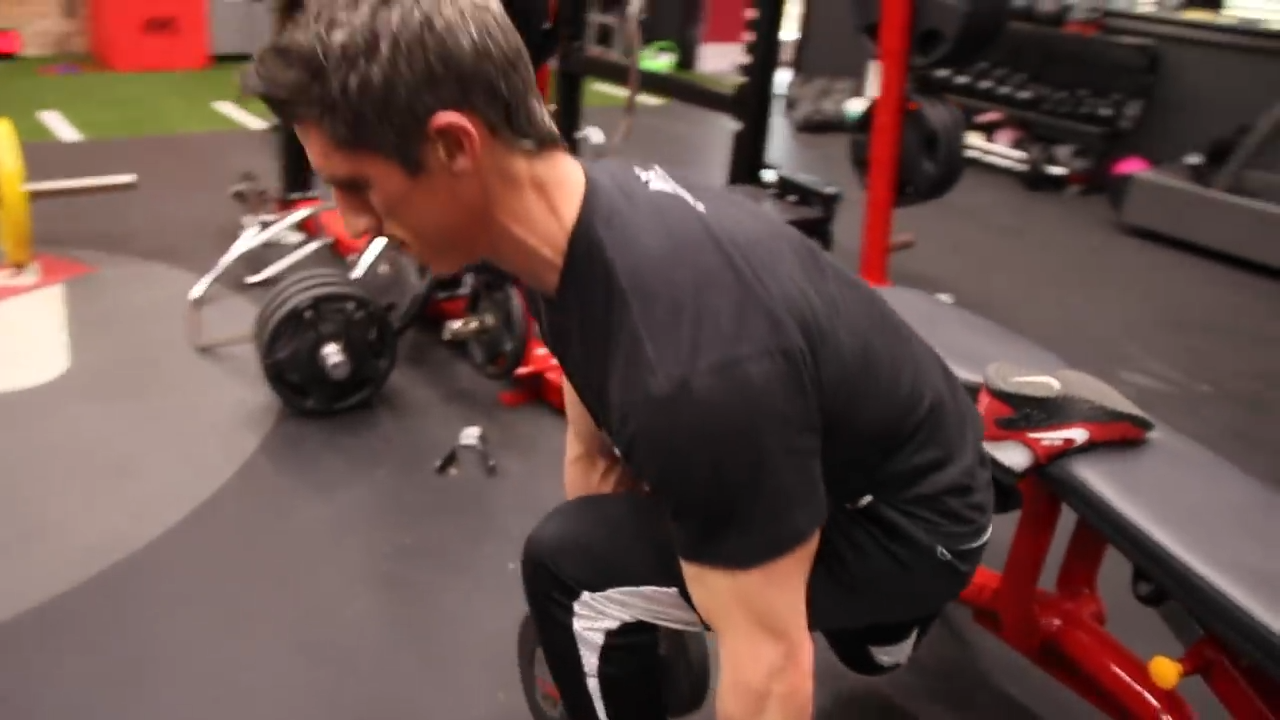
Then on the next rep, you’ll go down into a sprinter lunge position, which loads the posterior chain by placing the glutes under enormous stretch and increasing the muscle recruitment there.

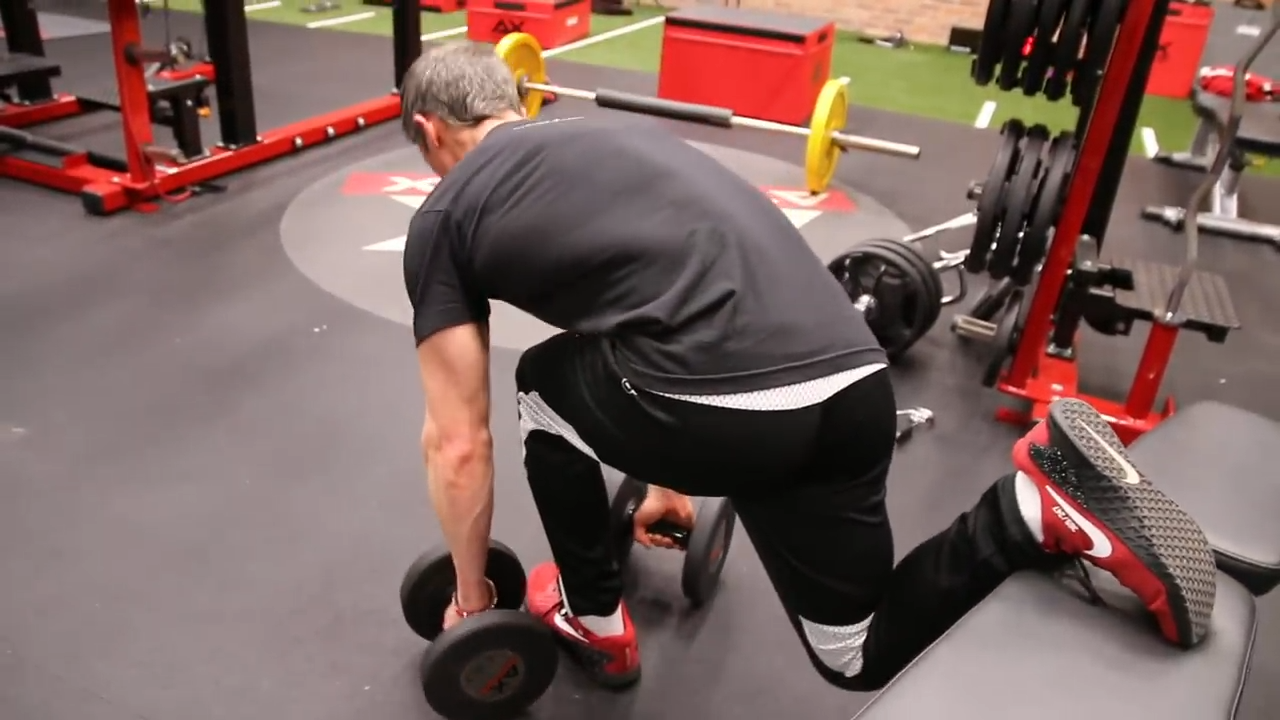
3B.) EXPLOSIVITY
Explosivity should be considered a part of all effective leg workouts.
To incorporate explosive movements into our leg workout we’re going to do a Bodyweight Plyo Bulgarian Split Squat which will go even further to build strong glutes and legs.
There are two key reasons this is an important and effective exercise to include in any bodyweight leg workout. One is that you should always try to speed up what you slow down so that you don’t get stuck in only slow patterns. When you only train slow you eventually become slow unless you try to become more explosive and deliberate with your movements.
The other reason explosivity is important is that it helps us train for stability of the knee in jumping and landing situations by challenging this function of the Vastus Medialis. Body weight leg exercises with jumps like this allow us to become a little more athletic in our training and to work on our balance, which should always be a goal of yours.
BODYWEIGHT PLYO BULGARIAN SPLIT SQUATS

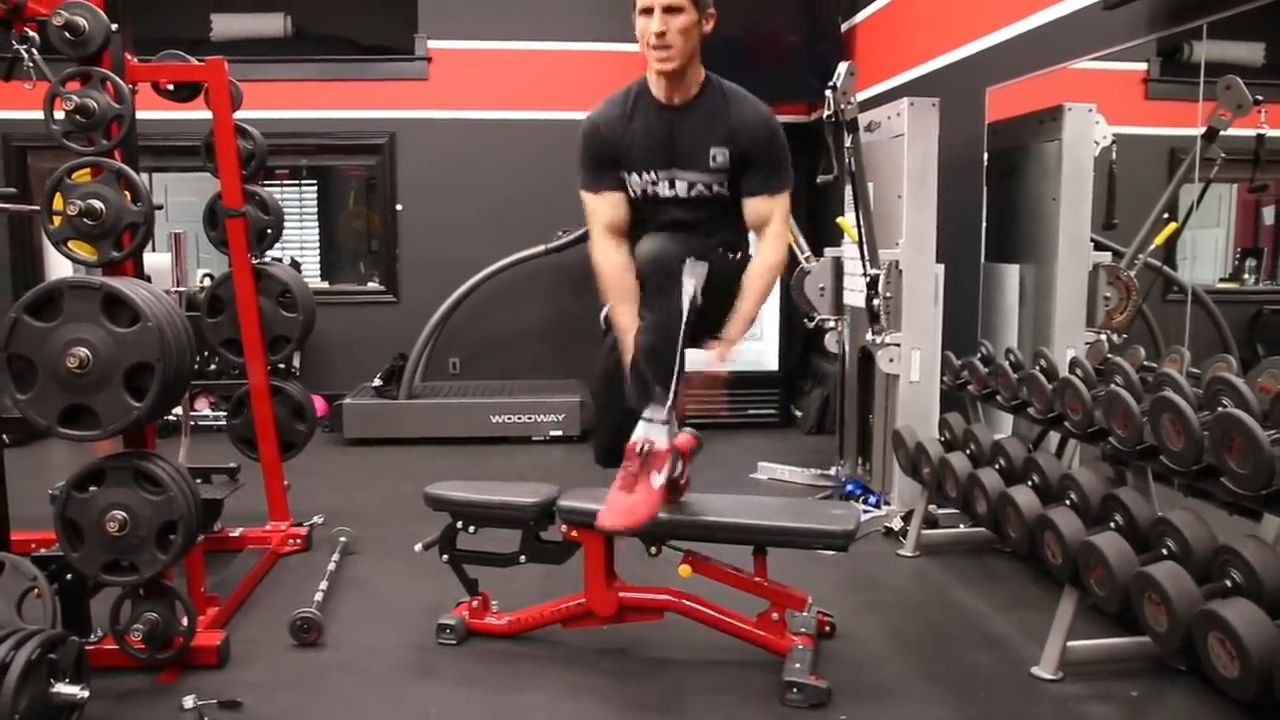
HOW TO DO THE BODYWEIGHT PLYO BULGARIAN SPLIT SQUAT:
- Starting position is in a staggered stance, perform bodyweight squats by jumping explosively pushing through the front leg and then clapping your hands under the back of the knee.
- Do 1 set of Bodyweight Plyo Bulgarian Split Squats to failure on each leg.
- Pay attention to your balance in this exercise and be sure not to use poor form.
4.) INSIDE AREA OF THE QUAD
It’s important to understand that there is no way to isolate the medial or inner portion of the quads during an exercise.
What you can do is influence its ability to contract fully and ensure it gets full stimulation by going to a full lockout position of extension on every rep. Instead of using a leg extension machine I prefer closed chain environments, where my foot is in contact with the floor.
The TKE Drop Lunge is a great way to ensure resistance through terminal knee extension. We can overload these dumbbell lunges with the addition of resistance bands as well.
TKE DROP LUNGE

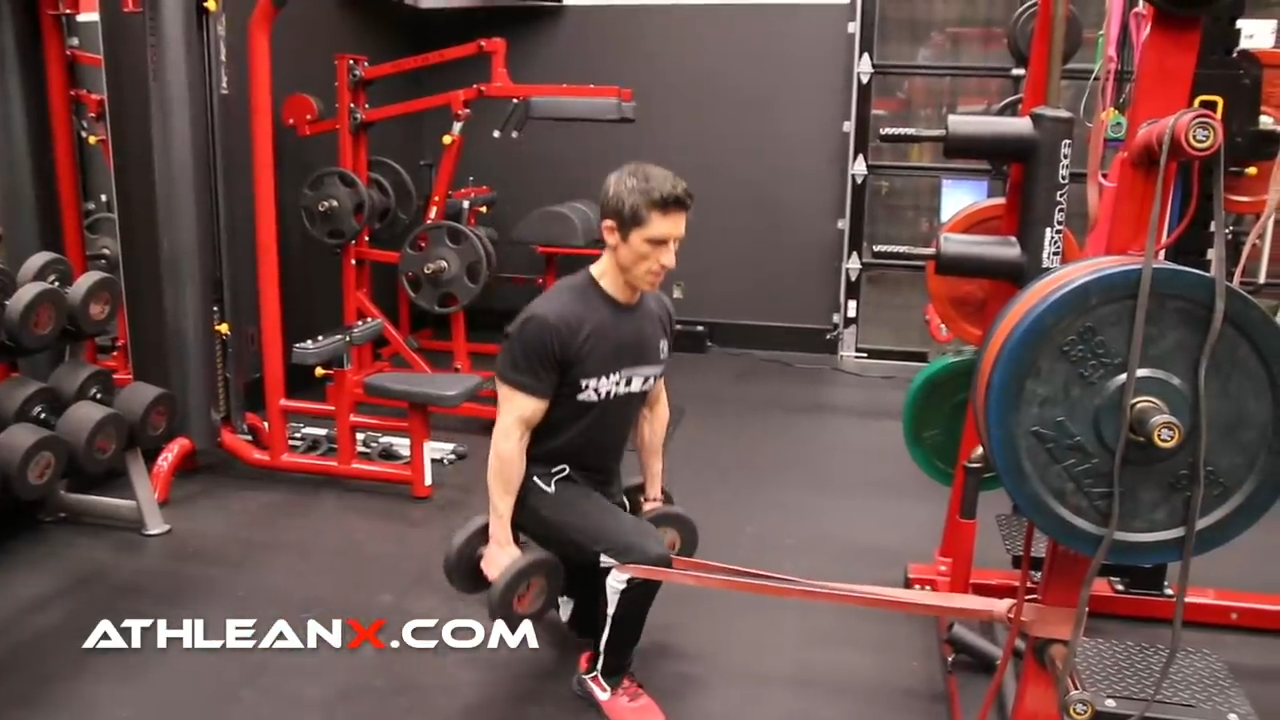
HOW TO DO THE TKE DROP LUNGE:
- You can use a pair of dumbbells in your hands to load this exercise fairly heavy.
- You’ll put the resistance band behind your knee and it will resist as you go down, pulling your knee forward.
- When you come back up, drive your knee back as hard as possible, into full extension.
- Do two to three sets in a rep range of 10 to 12RM in your hands for the drop lunge on each leg.
There’s no danger in driving your knee into full extension. It is a myth that lockout can be a damaging component of a joint’s function. In actuality it is part of the complete function of a joint.
5.) ADDUCTORS
No lower body workout routine would be complete without the additional focus on the adductors on the inside of our legs.
Many people believe that after hitting quads and hamstrings your bodybuilding leg workout is complete, but as a physical therapist I will tell you that’s not the case. I say it all the time: ALL MUSCLES MATTER.
We can hit the adductors very well with the Goblet Adductor Lunge, one of my favorite leg exercises with dumbbells. We are performing a lateral lunge on a slick surface to allow you to slide or squeeze your legs together to get yourself back to a standing position. Also, we’re using this exercise as an opportunity to work our legs in the transverse plane.
This will light up the important adductor muscle fibres on the inside of your thighs and help you to build inner thigh strength. You can do this on on a hardwood floor with your socks on.
DUMBBELL GOBLET ADDUCTOR LUNGE

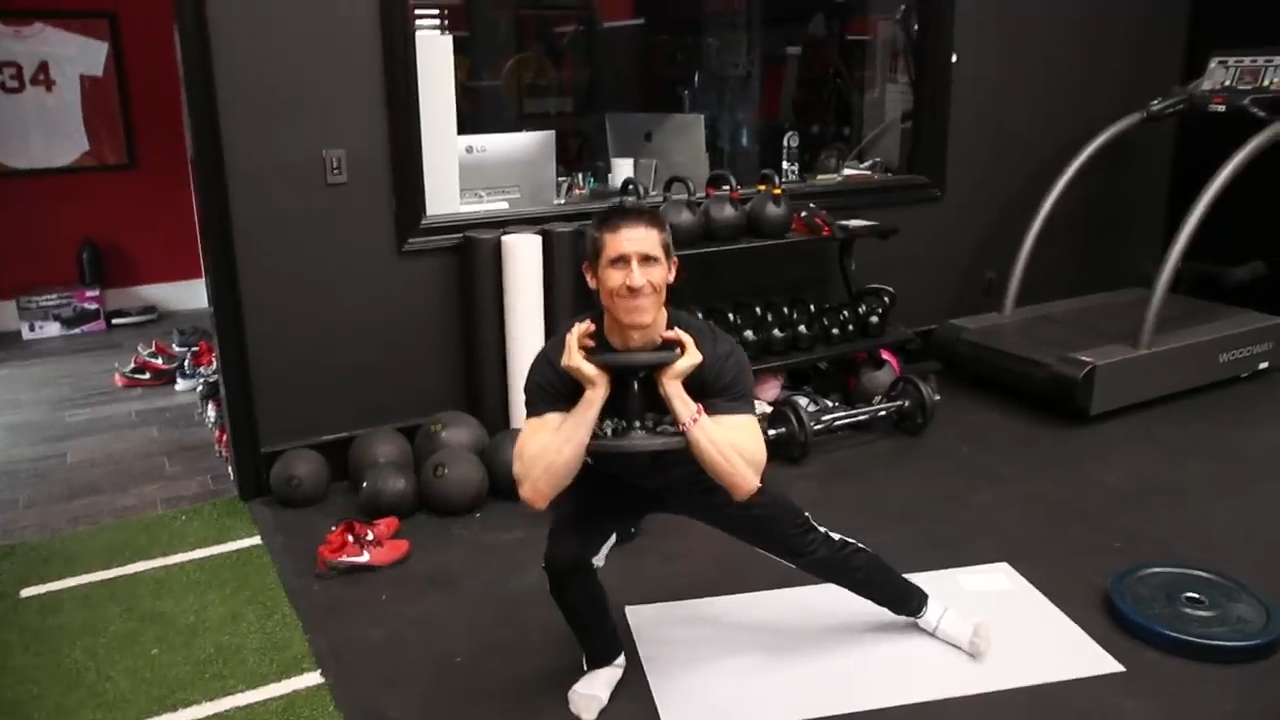
HOW TO DO THE DUMBBELL GOBLET ADDUCTOR LUNGE:
- Start on a flat surface with socks on to allow you to slide.
- Performing a lateral lunge, sliding outward and then squeeze your legs together to get yourself back to a standing position.
- Do two sets of 10 to 12 on each leg to hit these key muscles.
6.) ABDUCTORS
To wrap up this lower body workout routine we have to hit the outside abductors of the hips as well.
We’re going to accomplish this with a Hip Band Ladder finisher.
Sorry guys, but you’re going to hate me for this one!
You’ll notice that while there’s not a lot of resistance here, you’ll be burning like hell.
That’s because these muscle fibers are chronically weak.
The Hip Band Ladder requires that you work your way up from 1 rep to 10 reps in each direction of a side step while making sure to keep your toes pointed straight ahead at all times. Take a resistance band and anchor it against your arms and on the outsides of your feet.
Do not allow your toes to start drifting and turning outward because you’ll start to use muscles as a compensation rather than the abductors. During this finisher we’ll be working our legs in the frontal plane.
HIP BAND LADDER

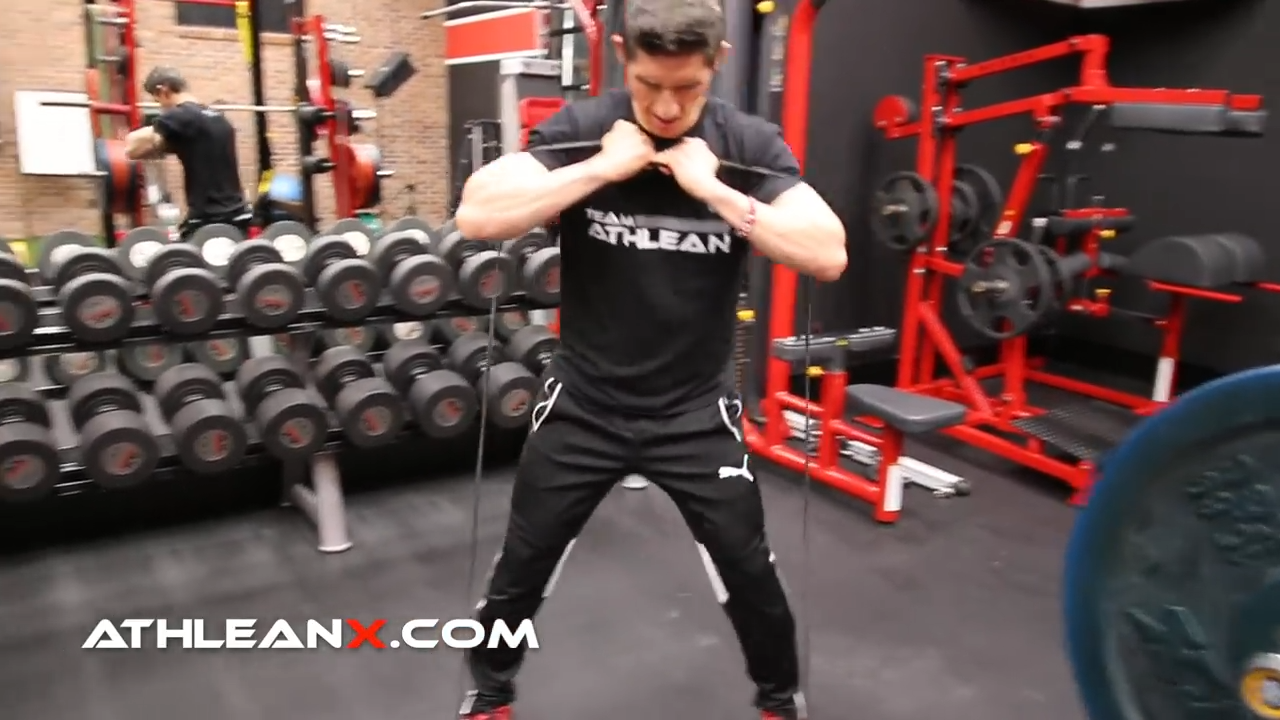
HOW TO DO THE HIP BAND LADDER:
- Take a resistance band and anchor it against your arms and on the outsides of your feet.
- Start with one step to the right and one step back to the left.
- Then two steps out to the right and two steps back to the left.
- Work your way up the ladder until you reach 10 steps in each direction.
- Make sure to keep your toes pointed straight ahead at all times and don’t let them drift outward. Be sure to include at least one set, and if you’re psychotic, you could add a second round.
As a physical therapist and strength coach, I’m telling you, if you haven’t done this complete lowr-body workout already, you’re in for a treat. Or at least you’re going to hate me. And that would be a good thing because you’re going to feel things in your legs that you’ve never felt before. Plus it will translate into important impacts on your strength and your physique.
This lower body workout routine is just one example of how training like an athlete means you don’t overlook a single muscle group! If you’re looking for a step by step program that lays out the science behind exercise selections and the reason why we do what we do, check out all of our complete ATHLEAN-X programs. Start training like an athlete and start looking like one fast!
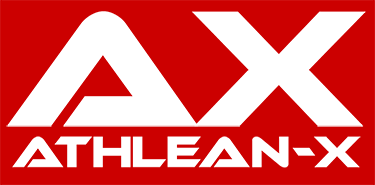
- The two main problems with most legs workouts is that they only work in the sagittal plane (ignoring the important transverse and frontal planes) and that they neglect many important muscle groups beyond those found in the quads and hamstrings.
- When we structure the best leg workouts, we want to be sure to work ALL the leg muscles including quads, hamstrings, abductors, adductors and the smaller muscles. We also want to be sure we’re working in the sagittal, transverse and frontal planes.
- A lower body workout plan should incorporate a variety of training elements: anterior and posterior chain compound lifts, single leg training to correct muscle imbalances, and direct targeting of inner portion of the quads, the adductors and the abductors.
LOWER BODY WORKOUTS FAQ
The most optimal leg workout will build leg strength and build muscle mass in all the of the largest muscles in the lower body including quad muscles, hamstring muscles, hip muscles, glute muscles and calf muscles. It would include compound lifts using heavier weight like standard squat training and hip thrusts as well as using dumbbells for leg movements like split squats (done in a split stance) and TKE drop lunges.
To create leg muscle growth faster you'll want to skip the leg press machine and the seated leg curl in your leg day workout and instead emphasize heavy lifts done with a loaded barbell like weighted squats and hip thrusts in your lower body workouts. Progressive overload in resistance training is what creates the fastest muscle development, and will help you see results much more quickly than bodyweight exercises (like air squats) for example. Squat exercises are an excellent exercise for progressive overload and leg development, but you'll want to be sure to follow proper form tips to reduce injury to the knee joint and hip joint. If you have pre-existing injuries such as hamstring injuries or knee injuries you should seek advice from a medical professional before beginning any leg training program.
Training legs daily would be too much training stimulus for these muscles, and wouldn't get the leg musculature enough rest to be able to grow. When training legs, most training programs prescribe weekly training volumes of 1-2 training days per week, whether you are training with compound movements, a dumbbell-only leg workout, bodyweight leg exercises or a combination of these. This is because muscles need adequate rest in order to be able to repair and grow. Regardless of how you are training, you need at least one 24-hour rest period between leg training sessions.
The quads are a powerful muscle, as are the hamstrings and glutes. They are some of the largest muscles in the body, and for this reason, if you follow the best leg training programs, you can see fast muscle development in the leg muscles, hip muscles and glute muscles.
One of the best exercises to include in your lower body strength routine is the basic squat. Once you begin training regularly with the squat, you can begin to increase your weight as you get stronger and you'll see a huge difference in muscle growth.
Lower body strength training trains all of the muscles of the legs and glutes. It could include an arsenal of moves like a lunge variation, a deadlift variation, a squat variation and some other single-leg moves to help build strength on both sides equally and prevent muscle imbalances. These exercises will help you build strong leg muscles and spark muscle growth as well.
It's best not to train lower body everyday, because this could hinder athletic performance and lower body development. To get your lower body stronger, it's best to train just 1-2 sessions per week, especially if you're working with heavier compound movements.
An upper body session would train the muscles of the upper body including chest, back, arms and shoulders, while a lower body strength workout would train the lower body muscles like the legs and glutes. A lower body strength training routine would include exercises like the basic lunge, the standard deadlift, the glute bridge exercise (or hip thrusts for more advanced programs). It could also include some unilateral moves to help avoid muscle imbalances.
Four of the best lower body movements for advanced programs include the basic squat, the basic lunge, the standard deadlift, and hip thrusts. These movements will help you see lower body gains relatively quickly if you shoot for overload and continue to increase the weight you're lifting as you grow stronger. For beginner training programs, basic movements and bodyweight exercises like air squats and bodyweight lunges and the glute bridge exercise are good places to start. These lower body strength exercises will help you form a solid foundation in the legs and glutes, and as you get stronger you can begin to add weight.
REFERENCES
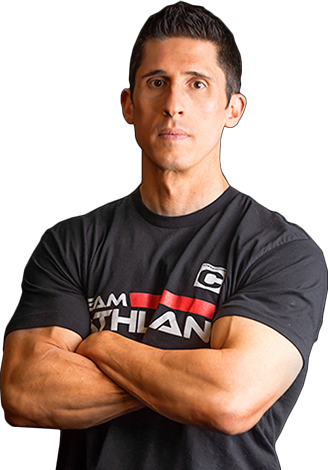
Jeff Cavaliere M.S.P.T, CSCS
Jeff Cavaliere is a Physical Therapist, Strength Coach and creator of the ATHLEAN-X Training Programs and ATHLEAN-Rx Supplements. He has a Masters in Physical Therapy (MSPT) and has worked as Head Physical Therapist for the New York Mets, as well as training many elite professional athletes in Major League Baseball, NFL, MMA and professional wrestling. His programs produce “next level” achievements in muscle size, strength and performance for professional athletes and anyone looking to build a muscular athletic physique.
